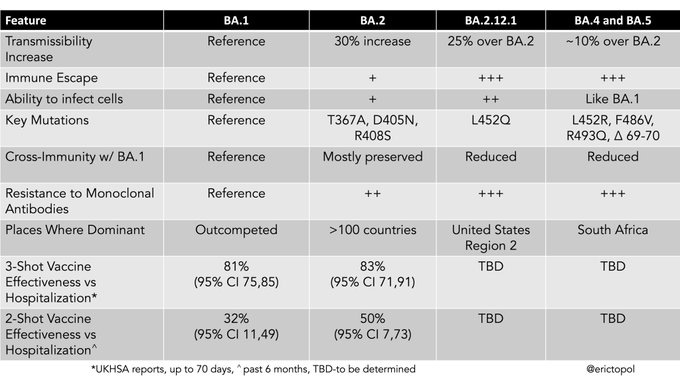SARS-CoV-2 Update: The 7th Wave
BA.2.12.1 continues surge in the United States leading to a new wave of cases.
The Counterpoint is a free newsletter that uses both analytic and holistic thinking to examine the wider world. My goal is that you find it ‘worth reading’ rather than it necessarily ‘being right.’ Expect regular updates on the SARS-CoV-2 pandemic as well as essays on a variety of topics. I appreciate any and all sharing or subscriptions.
The United States is well into it's seventh wave of COVID-19. The seven-day average of daily cases is 87,516, more than triple the recent low in case counts on April 5th. True case loads are almost certainly higher than reported, given the combination of asymptomatic cases, inadequate testing1, the prevalence of at-home antigen tests, and subpar reporting by some districts.
Omicron BA.2.12.1 continues to be the main driver of this wave, now representing nearly 50% of cases nationally, and a greater proportion in hard-hit regions, such as the Northeast.

While I previously believed that case counts would remain low through spring due to the United States' broad immunity wall and the shifting seasonality, this analysis did account for the development of yet another strain of CoV-2 with some capacity for immune escape. Omicron BA.4 and BA.5 are leading the way in Africa and Europe, while America struggles with BA.2.12.1.
The initial studies all suggest that each of these variants possesses a meaningful amount of immune escape.
Khan et al. studied the antibodies from individuals, all of whom had been infected with Omicron, and their neutralization ability against BA.4 and BA.5. After sorting these individuals by vaccination status, there was a three-fold drop in neutralization for vaccinated individuals, which increased to a seven-fold drop in neutralization for unvaccinated individuals (below, highlights mine). It is hypothesized that the smaller reduction in neutralization for vaccinated individuals is due to their immunity being broader, having been exposed both the wild-type spike protein (via vaccination) and the Omicron spike protein (via infection). Since the unvaccinated group has likely only encountered the Omicron spike protein (via infection), their narrow set of antibodies are mostly ineffective against BA.4 and BA.5.
Cao et al. performed a similar studying, but also including BA.2.12.1, finding that all three new strains possess a meaningful capacity to evade Omicron BA.1 immunity. They included a nice figure showing the different mutations between all the various Omicron sub-lineages (below).
These studies and others, along with increasing prevalence of these new strains and rising case counts in already-hard-hit nations, all suggest a meaningful amount of immune escape for BA.2.12.1, BA.4, and BA.5.
A summary of the Omicron sub-lineages is below.

Immunity Is Not Black & White
Our immune system is multi-layered defense and neutralizing antibodies are only one layer of the system. Others include non-neutralizing antibodies and the adaptive branch of the immune system, most importantly, T cells.
Of course, we’d all prefer to have strong neutralizing antibodies against these new strains. But the more opportunities your immune system has had to ‘train’ on a CoV-2 spike protein, the better your immune system will be at identifying and responding to any CoV-2 infection. The safest way to ‘train’ your immune system is through vaccination. Not only is vaccination less risky than CoV-2 infection, but it induces a broader set of T cells against CoV-2 than does infection: To quote Lang-Meli et al: “In vaccinees, we detected a broader spike-specific T-cell response compared to convalescent individuals.”
And while we don’t have specific data about the vaccines and these new strains, we should be optimistic that they remain robust. In fact, it is remarkable how effective they’ve held up against new variant after new variant and repeated dosing.
For example, the reason that the United States (and other nations) have approved second boosters is because they continue to reduce severe outcomes from CoV-2 infection. This is despite the vaccines’ stimulating you with a spike protein that doesn’t exist anymore. Two high-quality trials2 on second boosters have suggested an additional ~60% reduction in hospitalization compared to only one booster.

If you are eligible for your first or second booster, please schedule your appointment as soon as possible. Less than half of eligible Americans have received their first booster!
Hospitalizations and Deaths in United States
The United States has a broad and deep immunity wall. Though subpar when compared to other first-world nations, over two-thirds of the nation is fully vaccinated (two shots) and with our lackluster and polarized response to public health, the vast majority of Americans have been infected with CoV-2.
But BA.2.12.1 has certainly put a dent in that wall and hospitalizations are starting to increase. Given our immunity wall, I don’t believe we will see as drastic a rise as in either the Delta or Omicron BA.1 waves.
Moreover, because of that immunity-wall, I would also predict that deaths won’t rise to the levels of either the Delta or Omicron BA.1 waves. We had much less immunity going into these waves. For now, deaths have continued to stay low, but hospitalizations have only just started to increase and it takes time for severe cases to progress. In total, 998,740 Americans have died from confirmed COVID-19.
The seventh wave should be taken seriously; cases are rising dramatically. Some of these will progress to hospitalization and death.
As the situation changes, the risk changes. And while most people are not necessarily “at risk” from COVID-19, many people, such as the elderly and immunocompromised, are not as protected from vaccination or the ‘immunity wall’ as the average person and the vaccine remains unauthorized for children under five. Both individuals and communities must be consider in regards to infectious diseases.
And we know how to protect both individuals and communities: vaccinate, ventilate, and high-quality masks.
The nationwide positivity rate is nearly 10%.






